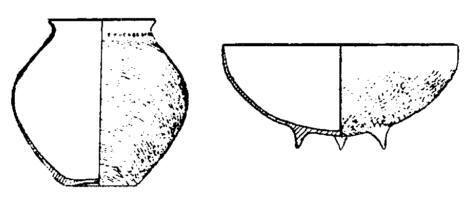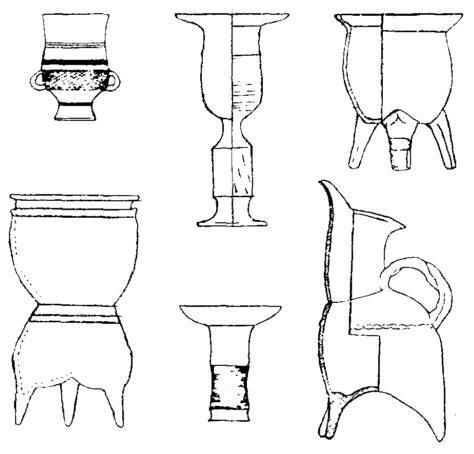Chapter 3 Section 2 On the banks of the Yellow River
Around 10,000 years ago, human society entered a new era, which is the Neolithic Age in archaeology.The Neolithic cultural relics that have been discovered in China today are dotted all over the land. On both sides of the Yellow River, on the north and south of the river, on the plateau, and on the islands, they have left the footprints of the ancestors everywhere, and the cultural relics created by the ancestors are buried everywhere.
The Yellow River Basin is the center of the origin of Chinese civilization and one of the areas with the most developed prehistoric culture.The distribution of Neolithic sites in the middle and lower reaches of the Yellow River is quite dense. Although this may be the reason why archaeological work has been carried out more deeply here, it also shows that the distribution density of prehistoric population in this area is obviously higher than that in other areas. The loess and the Yellow River nurtured prehistoric agricultural civilization. , which is also the foundation of the origin of Chinese civilization.
The earliest Neolithic cultures discovered so far in the Yellow River Basin include the Baijiacun culture in the Weihe region, the Cishan culture in the loess alluvial belt, the Peiligang culture, the Beixin culture and the Houli culture, all of which are relatively developed primitive farming cultures.In addition, cultural relics about 10,000 years ago were discovered at the Nanzhuangtou site in Xushui, Hebei Province, including several pottery fragments. This discovery may advance the beginning of the Neolithic Age in my country.
The Cishan Culture was named after the excavation of the Cishan site in Wu'an, southern Hebei in the 1970s.Cishan people made rough pottery and polished stone tools. The main grain they planted was millet, and they also raised pigs, dogs, cows, chickens and other livestock. They lived 8,000-7,500 years ago.The excavation of the Cishan site has just been completed, and another Neolithic site with an earlier age, Peiligang, has been excavated in Xinzheng, Henan. This type of site has been found in many places in central Henan, and it is named Peiligang culture.The pottery and stone tools used by the Peiligang people are similar to those of the Cishan people, and they made a very delicate toothed stone sickle.A circular semi-crypt house with a small living area, and a large-scale clan cemetery.People from Peiligang lived in the same era as those from Cishan, or even slightly earlier.
Hou Li Culture is named after the site of Hou Li Guanzhuang in Linzi, Shandong.The Houli people fired sandy pottery, and used stone, bone, and mussel production tools to engage in agricultural production, gathering, fishing and hunting.
The Beixin Culture was named after the excavation of the Beixin site in Teng County, Shandong, which was excavated almost at the same time as the Peiligang site.The Beixin people paid more attention to the decoration of the appearance when making pottery. They used ground stone tools and bone tools, and there were also a large number of ground stone tools. They lived a little later, around 7,200 years ago.
Cishan people, Peiligang people and Beixin people all lived on the alluvial fan in the lower reaches of the Yellow River, and on the Loess Plateau there also lived a group of early Neolithic residents——Baijia Village people (there is a little bit of nomenclature for this type of cultural relics. Big difference, here we use the most typical Lintong Baijiacun ruins to name it).The excavation time of several major ruins of Baijiacun culture was also in the late 1970s to early 1980s.People in Baijia Village made practical and aesthetically pleasing pottery, and invented painted pottery; they used polished stone tools, but the grinding was not fine; they lived in circular semi-crypt houses and had a small-scale public cemetery.People in Baijia Village lived around 7800-7000 years ago.
These earlier Neolithic cultures have certain similarities in connotation. For example, pottery is mostly tripod-shaped and drum-bellied (Fig. 1), and the crops are millet, which may have mutually produced each other during the development process. Certainly affected.These cultures later developed into a more prosperous and developed Neolithic culture. The Baijiacun, Cishan, and Peiligang cultures are the origins of the famous Yangshao culture, and the Beixin culture is the predecessor of the Dawenkou culture.The confirmation of this developmental relationship is not easy, it is the result of long-term joint efforts of many archaeologists.

Figure 1 Early Neolithic pottery in the Guanzhong area
The Yangshao Culture is the earliest Neolithic culture discovered in the Yellow River Basin. It was named after it was discovered in Yangshao Village, Mianchi County, Henan Province in 1921.After decades of excavation and research, people have a deep understanding of the appearance of Yangshao culture. It is mainly distributed in eastern Gansu, Shaanxi, southern Shanxi, Henan and adjacent areas. The Guanzhong Plain is the most developed area of this culture. Yangshao residents The era of life is about 7000-5000 years ago.Over a long period of time in this vast area, there are certain differences in the appearance of the Yangshao culture in various places. Archaeologists have divided it into several small cultural circles in order to understand their development and evolution process more accurately.
Residents of Yangshao lived a relatively stable and settled life, and had relatively large villages. Some ruins had a large area of more than 100,000 or even over 1 million square meters, including house sites, kiln sites, and large cemeteries.The housing is mainly semi-crypt type, and many consecutive houses have been invented.According to archaeological excavations, a large house site with an area of more than 100 square meters has been found.The production economy of the Yangshao people is mainly based on farming, and concurrently engages in livestock breeding, fishing and hunting.The main crops are millet and millet, and the livestock include dogs and pigs, as well as cattle, horses, chickens, and sheep, but it is not sure whether they are livestock.Yangshao people's pottery industry has developed to a mature stage, and the utensils are regular in shape, beautiful in decoration, and high in heat.Painted pottery is relatively developed, with red and black colors, brown and white colors, and smooth decoration.The Yangshao people have a large-scale public cemetery, and there are a certain number of joint burial tombs, and children generally use large pieces of pottery as burial utensils.
In the southern Shandong and northern Jiangsu areas in the lower reaches of the Yellow River, the Dawenkou culture developed following the Beixin culture. It was named after the excavation of the Dawenkou prehistoric cemetery in Tai'an, Shandong in 1959.The age of Dawenkou residents lived from 6300 to 4400 years ago, which was comparable to or slightly later than the age of Yangshao people.Like the Yangshao people, the Dawenkou people created a relatively developed farming culture. The main crop was millet, and they raised pigs, dogs and other domestic animals.The handicraft industry is relatively developed, with exquisite bone horn, ivory, and jade products.The level of pottery craftsmanship is also high, and wheel-made pottery appeared, with exquisite thin, black and white tires, and many painted pottery comparable to Yangshao Culture, and special wine vessels began to be produced.Dawenkou people have a relatively large public cemetery with a certain number of joint burials, and some of the deceased have relatively rich burial objects.
Developed after the Yangshao and Dawenkou Cultures is the Longshan Culture, named after it was first discovered in Longshan Town, Zhangqiu County, Shandong Province in 1928.At first, people called the late Neolithic sites in Shandong, represented by gray and black pottery, the Longshan Culture, and hundreds of similar cultural sites discovered in the middle reaches of the Yellow River were also included in the Longshan Culture.Later, for the sake of distinction, they were called Shandong Longshan Culture, Henan Longshan Culture, Shaanxi Longshan Culture, etc., and some even called the era represented by this type of culture the "Longshan Era".The Longshan cultures in various places have different origins and their own characteristics, and because they are similar in age and have more exchanges with each other, there are also many similarities.In the Longshan period, the pottery was generally made of wheel-making technology, and the fire was very high; the house construction was more particular, with rammed earth table-type foundations, and the living surface was painted with moisture-proof white gray surface; castles of a certain scale appeared, and the technology of sinking wells was invented; Large-scale cemetery, a few tombs are exquisitely built and rich in burial objects (Figure 2).
In Gansu, Qinghai and nearby areas in the upper reaches of the Yellow River, there is a prosperous painted pottery culture developed after the Yangshao Culture—the Majiayao Culture, named after the Majiayao site in Lintao County, Gansu Province discovered in the 1920s.Its age is about 5200-4000 years ago. In the development of more than a thousand years, it has changed a lot. It can be divided into three major stages, named as Majiayao, Banshan and Machang.Residents of the Majiayao culture mainly lived on the cultivation of millet and millet; painted pottery was quite well developed, and it was the most preferred branch of painted pottery among all Neolithic residents, mainly painted with varied geometric patterns, which are extremely rich. A sense of rhythm; most of the houses are semi-crypt, with a large public cemetery; they began to make small bronzes, which is one of the important achievements of the Majiayao people.

Figure 2 Shandong Longshan Culture pottery
The Qijia culture developed after the Majiayao culture, named after the discovery of the Qijiaping site in Guanghe, Gansu.The Qi family lived around 4,000 years ago, mainly farming, with dogs, pigs, cows, horses, donkeys, sheep and other livestock.There is also a certain amount of painted pottery painted with simple geometric patterns.The house is semi-cave, the same as the Longshan culture, and the living surface is painted with white gray surface.There are large-scale public cemeteries, the tombs are arranged neatly, and the number of burial objects is uneven.

Figure 1 Early Neolithic pottery in the Guanzhong area

Figure 2 Shandong Longshan Culture pottery
